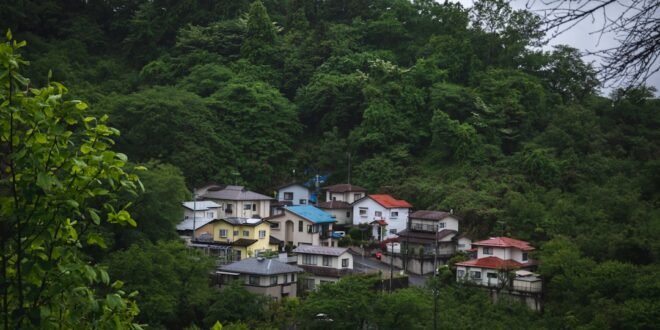Understanding Microclimates: Nature’s Hidden Patchwork
Microclimates are small, localized weather patterns that exist within a larger region. These unique areas can have significantly different conditions compared to their surroundings, often changing dramatically over just a few meters. Factors such as elevation, soil type, proximity to water bodies, and human development all play a role in shaping these microclimates. For instance, a shaded courtyard in a city might be several degrees cooler than a nearby sunlit street. Recognizing and understanding your local microclimate can offer valuable insights into why certain plants thrive and how the seasons affect your daily life.
Temperature Swings: More Than Just a Number
Temperature differences within a microclimate can be quite significant. A backyard might feel hotter than a front porch or vice versa, with variations of up to 10 degrees Fahrenheit. This happens due to factors like building materials, tree cover, and the orientation of structures. Urban areas often experience the “urban heat island” effect, where concrete and asphalt absorb and radiate heat, making cities warmer than rural areas. These temperature shifts influence everything from clothing choices to the speed at which ice cream melts on a summer day.
Humidity Levels: The Invisible Factor
Humidity plays a crucial role in defining a microclimate. Areas near large bodies of water or dense forests typically have higher humidity, which can make the air feel warmer in summer and colder in winter. Conversely, regions shielded from moisture sources, such as hilltops or dry urban pockets, may feel much drier. Even subtle changes in humidity can impact comfort, plant health, and the likelihood of mold or mildew in homes.
Rainfall Patterns: Why It Pours Here, But Not There
Rainfall distribution is not uniform across an area. Local topography, including hills, valleys, and buildings, can channel or block rain clouds. Coastal regions often see more frequent showers due to moist air from the sea, while rain shadows—areas blocked by mountains—may receive less precipitation. Recognizing these patterns can help prepare for sudden storms or droughts and guide decisions about planting.
Wind Patterns: The Unseen Sculptor
Wind can vary from a gentle breeze to a strong gust depending on the microclimate. Natural windbreaks like forests, hills, and buildings can shield areas from strong winds, while open fields or valleys might funnel and intensify them. Some microclimates are known for persistent breezes, such as coastal bluffs or mountain passes. Wind affects not only comfort but also landscapes, evaporation rates, and wildlife behavior.
Frost Pockets: The Garden’s Secret Enemy
Cold air tends to settle in low-lying areas, creating frost pockets that can damage plants even when forecasts predict safe temperatures. A slight change in elevation can mean the difference between a thriving garden and one affected by frost. Knowing where these pockets form can help protect plants and improve gardening strategies.
Sun Exposure: Light and Shadow’s Big Impact
Not all areas receive the same amount of sunlight. The angle of the sun, shade from trees or buildings, and reflective surfaces can drastically affect local temperatures. A south-facing slope might bask in sunlight, while a north-facing one stays cool and shaded. This impacts not only plant growth but also home heating and cooling efficiency.
Soil Moisture: The Ground Beneath Your Feet
Soil is a vital component of microclimates. Sandy soils drain quickly, making some areas drier, while clay-rich soils retain moisture, staying soggier after rain. The type of soil influences how much water plants receive and how quickly evaporation occurs. Microclimates with consistently moist soil can support different crops than those that dry out quickly.
Elevation: A Few Feet Make a Difference
Even a slight change in elevation can alter weather conditions. Higher ground often has cooler temperatures and more wind, while valleys can trap heat and moisture. This is why grapes grown on a hillside might taste different from those in a valley. Elevation also affects frost risk and the timing of spring blooms.
Proximity to Water: Nature’s Air Conditioner
Bodies of water like lakes, rivers, and ponds can moderate local temperatures. Water heats up and cools down more slowly than land, leading to milder winters and cooler summers. This is why coastal climates differ from inland areas, even when they are close. Proximity to water can also increase humidity and protect plants from extreme temperature swings.
Vegetation: The Living Shield
Forests, shrubs, and gardens influence microclimates by providing shade and releasing moisture through transpiration. This creates a refreshing environment during heatwaves. Conversely, areas with little vegetation can heat up quickly and become drier. Plant life acts as a natural air conditioner and humidity regulator.
Urban Microclimates: The City’s Unique Signature
Cities have their own distinct microclimates shaped by skyscrapers, asphalt, and traffic. These elements create heat islands where temperatures are higher than in rural areas. Urban parks and green roofs can mitigate this, while shaded alleys might feel chilly even on warm days. Street layout and building density affect wind flow, rainwater runoff, and sun exposure, making each city block a unique microclimate.
Coastal Influences: Where Land Meets Sea
Living near the ocean or a large lake brings unique weather characteristics. Sea breezes can keep summers cool and winters mild, while fog and salty air influence everything from plant growth to vehicle rust. Coastal microclimates are complex and constantly shifting with tides, wind direction, and water temperature.
Mountain and Valley Contrasts: Up and Down the Weather Ladder
Mountains and valleys create dramatic microclimate differences. Mountains force air to rise, cool, and release moisture, resulting in wetter conditions on the windward side and drier, warmer air on the leeward side. Valleys can trap cold air and fog, creating chilly microclimates even in otherwise warm regions. These contrasts lead to diverse ecosystems in close proximity.
Seasonal Shifts: Microclimate’s Changing Face
Microclimates evolve with the seasons. A shady spot perfect for summer picnics might become icy in winter. Urban heat islands can intensify summer heatwaves but keep cities warmer during cold snaps. Understanding seasonal shifts helps prepare for the unexpected and make the most of each season.
Human Influence: How We Change the Weather Around Us
Human activities shape microclimates in various ways. Planting trees, paving driveways, or installing a swimming pool can alter local temperature, humidity, and wind flow. Urban planning decisions, such as adding green spaces or changing building materials, can make cities more livable by mitigating extreme temperatures. Even garden choices can influence microclimates.
Wildlife Clues: Animals Know Best
Observing wildlife can reveal microclimate details. Birds, insects, and other animals often choose spots with ideal warmth, shelter, and moisture. Bees, butterflies, and lizards are sensitive to microclimate differences. Noticing these patterns can help create a more inviting environment for all creatures.
Gardening and Agriculture: Microclimate Matters Most
Farmers and gardeners rely on microclimate knowledge to select the best crops and planting times. A south-facing slope might be ideal for grapes, while a frost-prone valley floor favors cold-hardy apples. Understanding microclimates can transform a vegetable patch from disappointing to flourishing.
Technology and Microclimate Mapping: Seeing the Unseen
Modern technology allows for precise microclimate mapping. Affordable weather stations, smartphone apps, and satellite data track temperature, humidity, and wind at a hyper-local scale. Cities use this information to plan green spaces and improve public health. For gardeners and outdoor enthusiasts, these tools unlock secrets about the best places to plant, play, or relax.
Climate Change: Microclimates in Flux
Climate change is altering microclimates globally. Rising temperatures, changing rainfall patterns, and extreme weather events are making microclimates more unpredictable. Some areas may face increased drought, while others see unexpected frost or flooding. Understanding local microclimates can help adapt to these changes, whether growing food, building a home, or planning a weekend.
Personal Experience: Living With Your Microclimate
Everyone has a unique microclimate story. It could be a corner of the yard where snow lingers, a suntrap on a balcony, or a breezy hill where you go to cool off. Tuning into these patterns enriches everyday life and makes it more comfortable. No meteorology degree is needed; a bit of curiosity and attention to detail can uncover the secrets of your own patch of Earth.
 Info Malang Raya Its All About World News
Info Malang Raya Its All About World News




